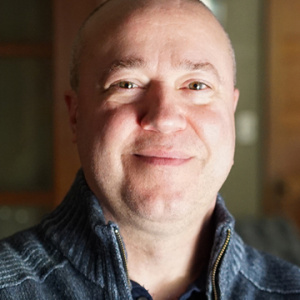The Plot Twist of Disruption

Have you ever read an action-thriller novel or watched a mystery movie that kept you on the edge of your seat, only to learn near the end of the story that things are not what they seemed? This famous literary technique known as the “plot twist” jolts an audience’s perception, introduces a surprising conflict, or radically alters the context of the story in order to produce an unexpected outcome. Like the appearance of the Statue of Liberty at the end of Planet of the Apes, the spectral revelation in The Sixth Sense, or the unmasking of the paranormal villain in every episode of Scooby Doo, a good plot twist will have most of us exclaiming, “I didn’t see that coming!” (The rest of us are just annoyed that we were tricked.)
Plot twists can be revealed in many different ways. For instance, some stories may contain a “flashback” that surprises the audience with previously unknown information that cracks the case. Others set up the plot twist through a “red herring” or a false clue that is intended to lead the audience to an incorrect conclusion. The most popular form of a plot twist is known as the “anagnorisis” – the sudden discovery of the true identity or nature of a character. This epiphany often reframes the purpose or meaning of the story, and leaves the audience second-guessing every person and event that they have seen.
When attempting to guide our organizations successfully through the minefields of disruption, most innovators, strategists and leaders look to address a number of familiar and well-defined tropes: a tipping point in price or performance; a dramatic increase in accessibility or capability; a move toward ubiquity reflected in reaching new markets and consumers; or a new application for well-established ideas and technologies. These descriptions of disruption can make for an interesting story, but they don’t necessarily contain any real plot twists. These well-worn signals can alert savvy leaders to potential risks, offering up a fairly predictable definition of the what, when, where and how of disruption.
However, we don’t live in a predictable world. As a matter of fact, we have never seen a more volatile, complex, and transformative landscape in history than the one that we are experiencing today. This sea change has left many of us feeling much less certain and empowered when it comes to making the right decisions, pulling the right levers or identifying the right investments in the face of disruption. In this new reality, it’s clear that we must systematically look out for risks—and opportunities—in completely unexpected areas. We must learn to identify forces of disruption not only in technological realms that have a direct connection to our industry, but also from the perspective of change across social, economic, environmental, and political sectors that have no historical connection to our traditional scope or strategies. Truth be told, the very identity and nature of disruption seems to be changing – as well as the nature of the disruptors themselves – and we are being forced to face an unnerving truth: disruption contains a huge plot twist.
Drawing upon advancements in open innovation and knowledge management practices, scientist and researcher Ilkka Tuomi explained this shifting nature of disruption as an emergent property of increasingly complex models of change:
“Unpredictability has two main sources: epistemic uncertainty (a lack of clarity due to incomplete knowledge) and ontological unpredictability (ambiguity about the nature of a person, event or object). When disruptive and downstream innovation become frequent, ontological unpredictability becomes increasingly important for innovation policy and strategy. The analysis of the nature of ontological unpredictability explains why future-oriented technology analysis and foresight frequently fails to grasp socially and economically important technical developments, and clarifies the reasons why policy, strategy and future-oriented analysis need to move beyond evidence-based approaches… Ontological expansion means that we do not need a better model; instead, we need a different model.” (1)
When leaders define disruption largely from the view of epistemic uncertainty, they become tied to the present-day trends and concepts that lure them into creating improved approaches to traditional models. When executives and entrepreneurs shift their focus to defining disruption through ontological unpredictability, they transport themselves and those around them to a place of ongoing discovery and creativity. In this way, organizations can move beyond the dangerous expectation that disruption will follow a conventional narrative to uncovering the clues that are pointing to a shocking plot twist.
In order to understand how today’s trends and innovations are undergoing an exponential change in their very nature rather than simply morphing through incremental growth, we have identified a group of large-scale technological and social disruptors. Each of these discontinuities are evolving through the convergence of multiple technological and social provocations that are thrusting massive transformation upon economies, businesses and individuals.
Hyperweb
A perfect example of the changing nature of disruption is the emerging properties and utility of the World Wide Web. Originally created to store and share information, it is now used by approximately 3.5 billion individuals to reframe business, education and lifestyles. Looking beyond its basic functions, the creator of the web – Sir Tim Berners-Lee – saw a much greater use for it than simply being an information highway for the masses. Addressing the deeper purpose and potential of the web, he famously stated in modern-day prophetic language,
“The Web as I envisaged it, we still have not seen it yet. The future is still so much bigger than the past.” (2)
With each passing day, this quote becomes more prescient. Today, most of humanity cannot fathom the potentially profound changes that are at our doorstep through new developments.
Sobotics
Whether robots largely continue to manifest as commonplace devices that blend into our everyday routines or become so life-like that no one can tell the difference between humans and humanoids, there is little doubt that robots are poised to radically change the way we learn, work, create, and relate to one another, and even perceive what it means to be human.
Does the inevitable “rise of the robots” – particularly the social or relationship-oriented variety that have permeated our global zeitgeist – have the power to aid in the cognitive evolution of the human race? If so, what type of change will the age of social robotics bring to the way we see the world around us?
Once we have fully integrated robots into our everyday lives and elevated them to the status of “mechanical species,” it follows that robots could then naturally fill all of the roles in society that constitute the modern definition of a “job,” freeing humans to live with greater passion-oriented purpose.
Everyware
Wearables went mainstream in the early 2000’s with the advent of Bluetooth technology, and over the next decade wearable devices such as the Fitbit (technology to track physical activity) and Google Glass (an optical display that acted as an ubiquitous computer) were released.
2014 was designated “The Year of Wearable Technology,” and since that time the idea that we can wear devices that can administer an ECG, modify our brainwaves, generate and stop energy through our clothing, or allow us to actively modify our dreams to accelerate innovation has skyrocketed, with industry experts estimating the market to be worth $25 Billion by 2019. (3) However, this is only the tip of the iceberg, as such technology is granting us the ability to connect to the world around us in unique ways, experience life from novel perspectives and augment our existence for extraordinary results.
Posthuman
In his bestselling book Sapiens, Israeli historian Yuval Noah Harari comes to a provocative and startling conclusion: humanity – at least the way we are defining it today – will disappear within the next century. (4) The authors of a recent essay in Science echo Harari’s controversial view, proclaiming that “Perhaps in a century, the term ‘human being’ will be an object of nostalgia rather than a single moral category.”(5) Nick Bostrom, the director of the Future of Humanity Institute at the University of Oxford, even argues that becoming “posthuman” could be seen as an “extremely worthwhile” step in our evolutionary development. (6)
However, as controversial as those statements may seem, it’s even more shocking to realize that we are already well on our way to redefining what it means to be human. The fact that we are intentionally accelerating our own evolution isn’t relegated to some sci-fi vision of the future, and this present-day transformation is reflected in the changing nature of what is driving our thinking, decisions, and actions as a species.
These disruptions, as well as many others, are transforming the nature of innovation and breakthroughs in today’s organizations. So, next time that you find yourself convinced about the identity of the players and structures that are altering the fabric of your industry, stop and ask yourself, “Is the outcome of this story obvious, or is there a plot twist in my future?”

Frank Spencer
Co-Founder
Creative Director
In 2009, Frank founded Kedge – a global foresight, innovation, and strategic design firm which pioneered TFSX. Throughout his career, Frank has worked as a leadership coach and developer with entrepreneurs, social communities, networking initiatives, and SMEs, helping them in areas such as development, innovation, and networking.
Read More
Yvette Montero Salvatico
Co-Founder
Managing Director
Holding a bachelor’s degree in Finance and an MBA from the University of Florida, Yvette has over 15 years of corporate experience with large, multi-national firms such as Kimberly-Clark and The Walt Disney Company. Before co-founding TFSX, she led the effort to establish the Future Workforce Insights division at the Walt Disney Company, identifying future workforce trends and leveraging foresight models and techniques to assess potential threats and impacts, emerging ideas, and exciting opportunities for the organization.
Read More
